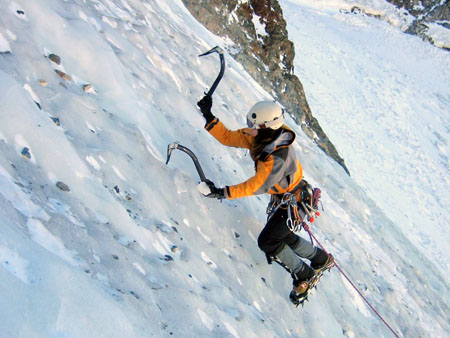Climbing in high, snow-covered mountains places special requirements upon photographers, their equipment and techniques. To get worthwhile images it is obviously necessary to be a competent climber. Pictures taken from the road look remote and unexciting when compared to images obtained from ice faces and narrow ledges overlooking stunning views.
Close-up photographs of other climbers can be interesting but may lack impact if they show little or nothing of the surroundings. Those of the mountain scenery are interesting but may all look the same to a non-climbing viewer. The best approach is probably therefore to aim to show the climber working in the mountain environment. The height and precipitous nature of the slope on which a mountaineer is situated add impact to an image. Combine this with extraordinary background scenery and sufficient detail of the climbers and their activities, and worthwhile images begin to emerge.
 |
|
Public domain image by Tom Cronin, California Mountaineering Group, License. [[File:Agnes Sauvage - Dana Couloir - Mt. Dana - California 2.JPG|Agnes Sauvage - Dana Couloir - Mt. Dana - California 2]] |
Equipment must be rugged, water resistant and capable of withstanding low temperatures. Use a camera that will accept AA lithium batteries. Cameras should also be lightweight, equipped with autofocus so they can be used with one hand, and convenient to use while wearing gloves. They should also be attached to the body or the climber's harness with a lanyard. Accessories should be attached to the camera with short cords.
Exposure meters can be deceived by all-white surroundings, and may sometimes underexpose so that the snow becomes grey. However, modern matrix-metering systems are very effective and adjustments may not be necessary with good-quality cameras. UV filters and lens hoods are useful accessories if the climber feels able to carry and use them. Film or digital equipment is effective, but both have their advantages and disadvantages. Film can crack at low temperatures and rolls often need changing at inopportune moments. Digital cameras consume lots of battery power and the displays are almost impossible to use in bright light. Wide-angle zoom lenses are a good overall choice but selection obviously depends upon what type of images are required.
A final worthwhile tip is to cover as much as possible of the camera and lens with gaffer tape, This not only protects the equipment from rough treatment, but also prevents the climber's face and hands from freezing to cold metal surfaces. Some climbers also claim that the tape-covered cameras are less likely to be stolen because they look battered and old.






